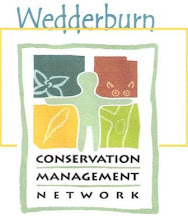
A healthy stand of the rare Ploughshare Wattle, Acacia gunnii, was discovered during the first week of July by Alison Jeavons of Greenhouse Balanced. The stand included some 12 individuals of which two were flowering prolifically. Alison was busy seeding the new Greenhouse Balanced block wedged between the Skinners Flat and Woosang blocks of the Wychitella Nature Conservation Reserve when she noticed the creamy colours of the flowers of the rare plants out of the corner of her eye.
The flowers look very much like the flower of the Spreading Wattle, Acacia genistifolia, which is also present at the block in large numbers. However, Alison noticed that the prostrate growing habits of the Ploughshare were very different and on closer inspection made the exciting identification.
There have only been two previous recordings of this species in our district, both in the Korong Vale block of the Wychitella NCR. Wedderburn is on the furthest north-western edge of the natural range of this plant, which occurs in all Eastern States but in very low numbers. The newly discovered stand will be protected as the revegetated Greenhouse Balanced blocks in Wedderburn are all covenanted through Trust for Nature. Good news for the long term survival of this species in our region.
Article and photograph by Jeroen van Veen
The flowers look very much like the flower of the Spreading Wattle, Acacia genistifolia, which is also present at the block in large numbers. However, Alison noticed that the prostrate growing habits of the Ploughshare were very different and on closer inspection made the exciting identification.
There have only been two previous recordings of this species in our district, both in the Korong Vale block of the Wychitella NCR. Wedderburn is on the furthest north-western edge of the natural range of this plant, which occurs in all Eastern States but in very low numbers. The newly discovered stand will be protected as the revegetated Greenhouse Balanced blocks in Wedderburn are all covenanted through Trust for Nature. Good news for the long term survival of this species in our region.
Article and photograph by Jeroen van Veen

No comments:
Post a Comment